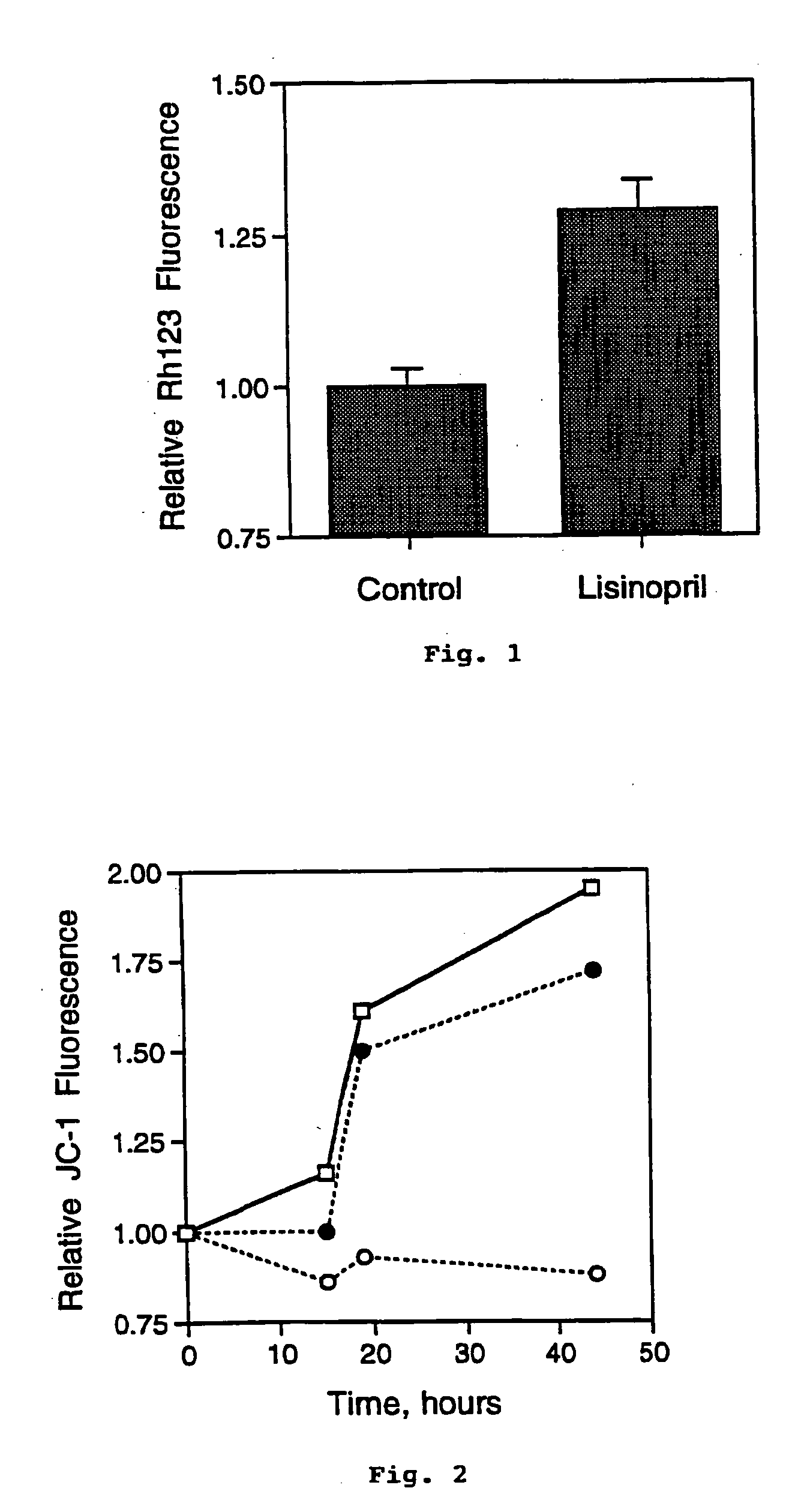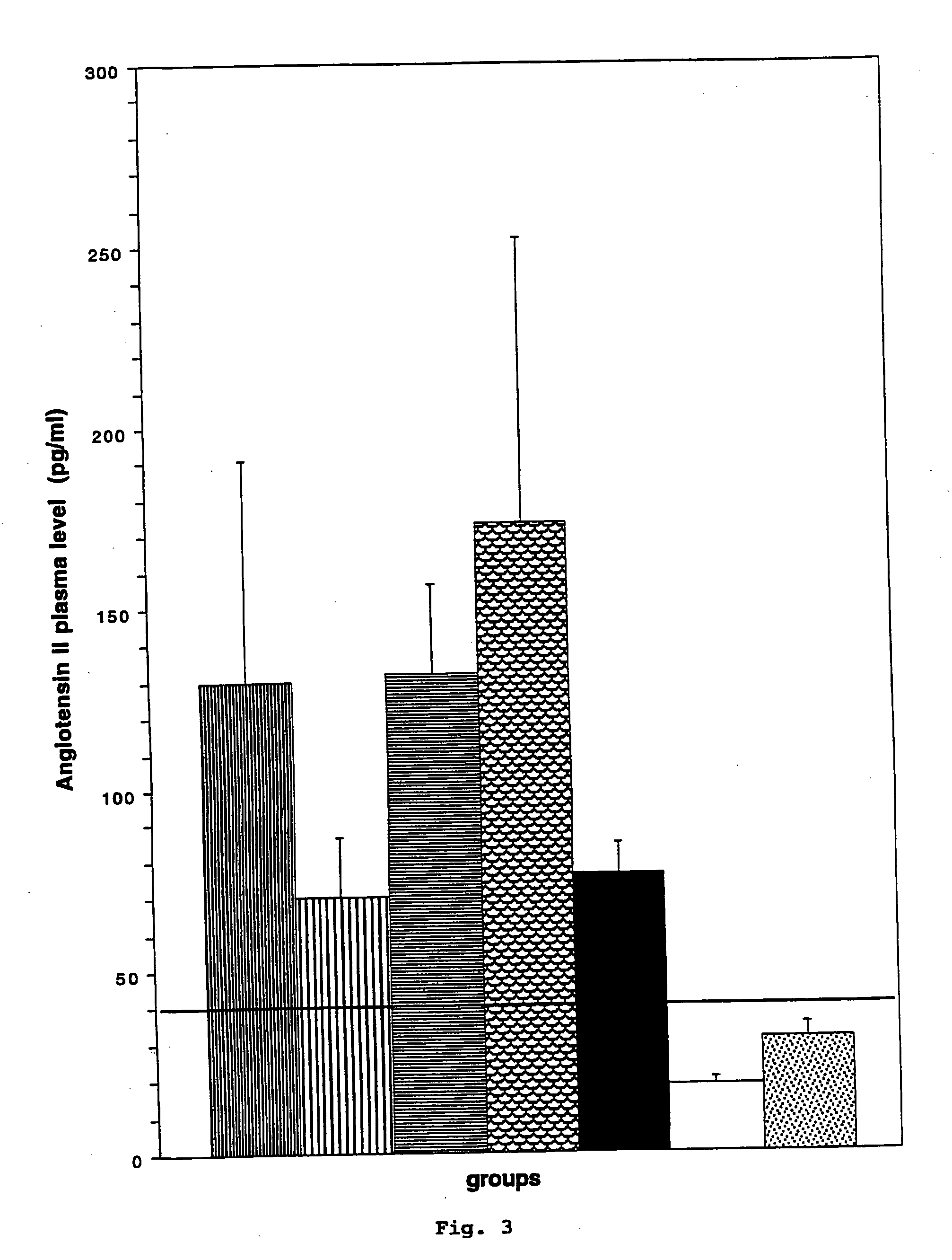Use of inhibitors of the renin-angiotensin system
a technology of angiotensin and inhibitors, which is applied in the direction of biocide, plant growth regulators, biochemistry apparatus and processes, etc., can solve the problems of increased mortality, wasting in the affected territory, and generalised weight loss, and achieves the effect of increasing blood flow and glucose uptak
- Summary
- Abstract
- Description
- Claims
- Application Information
AI Technical Summary
Benefits of technology
Problems solved by technology
Method used
Image
Examples
example 1
[0121] This Example demonstrates that ACE inhibitors increase the mitochondrial membrane potential of cardiomyocytes. It is based on observation of the potential difference (ΔΨm) across the inner mitochondrial membrane that is generated by the extrusion of protons to the outside of the mitochondrion during the transport of electrons from electron-carrying coenzymes to molecular oxygen. Part of the energy stored in ΔΨm is utilised to support the synthesis of most of the ATP derived from aerobic metabolism. Thus, ΔΨm is an indicator of the energisation state of the mitochondrion, and also of the efficiency of oxygen utilisation to generate chemical energy. To investigate whether some of the therapeutic properties of ACE inhibitors could be accounted for by an increase in ΔΨm, this parameter was examined in rat cardiomyocytes, following pre-treatment with the ACE inhibitor lisinopril.
[0122] More particularly, cardiomyocytes were isolated from new-born Sprague-Dawley rats hearts and ma...
example 2
[0127] Ninety military recruits were studied before and after military training of 12 weeks duration. These were randomised to receive the AT1-receptor antagonist Losartan or placebo.
[0128] There was a consistent trend for the recruits to improve their VO2max at anaerobic threshold, although a distinction was observed, according to genotype. The results shows a gain of 2.1±6.8 ml / min for II genotype on placebo vs. −1.1±6.5 ml / min for DD genotype on placebo, and a gain of 0.3±6.3 ml / min for II on losartan vs. −1.8±6.3 ml / min for DD on Losartan. When combined, the difference in gain was 1.3±6.6 ml / min for II on vs. −1.4±6.4 ml / min for DD: p 0.07).
[0129] The data for VO2max showed a similar trend, as did measures of muscle fatigue. These data are consistent with an enhanced ability, especially for those of II genotype (and thus lower ACE activity) to achieve higher workloads, before reaching anaerobic threshold, and therefore to be more resistant to fatigue in situations of moderate ...
example 3
[0130] The bioactive element of the renin angiotensin system (RAS) is angiotensin II (AT II). Elevations of AT II in plasma or in local tissue would indicate conditions in which inhibition of the RAS may have significant therapeutic benefit even where partial inhibition of the RAS has been achieved (such as by therapy with ACE inhibitors).
[0131] ATT II was measured as follows: Blood samples were collected after supine rest of at least 10 minutes. An antecubital polyethylene catheter was inserted and 10 ml of venous blood were drawn. After immediate centrifugation, aliquots (EDTA plasma sample) were stored at −70° C. until analysis. Angiotensin II was measured using a commercially available radioimmunoassay (IBL, Hamburg, Germany, sensitivity 1.5 pg / ml). After extraction of the plasma samples, AT II is assayed by a competitive radioimmunoassay. This radioimmunoassay is using a rabbit anti-AT II antiserum and a radio-iodinated AT II tracer. Bound and free phases are separated by a se...
PUM
| Property | Measurement | Unit |
|---|---|---|
| distance | aaaaa | aaaaa |
| fat weight | aaaaa | aaaaa |
| time | aaaaa | aaaaa |
Abstract
Description
Claims
Application Information
 Login to View More
Login to View More - R&D
- Intellectual Property
- Life Sciences
- Materials
- Tech Scout
- Unparalleled Data Quality
- Higher Quality Content
- 60% Fewer Hallucinations
Browse by: Latest US Patents, China's latest patents, Technical Efficacy Thesaurus, Application Domain, Technology Topic, Popular Technical Reports.
© 2025 PatSnap. All rights reserved.Legal|Privacy policy|Modern Slavery Act Transparency Statement|Sitemap|About US| Contact US: help@patsnap.com


